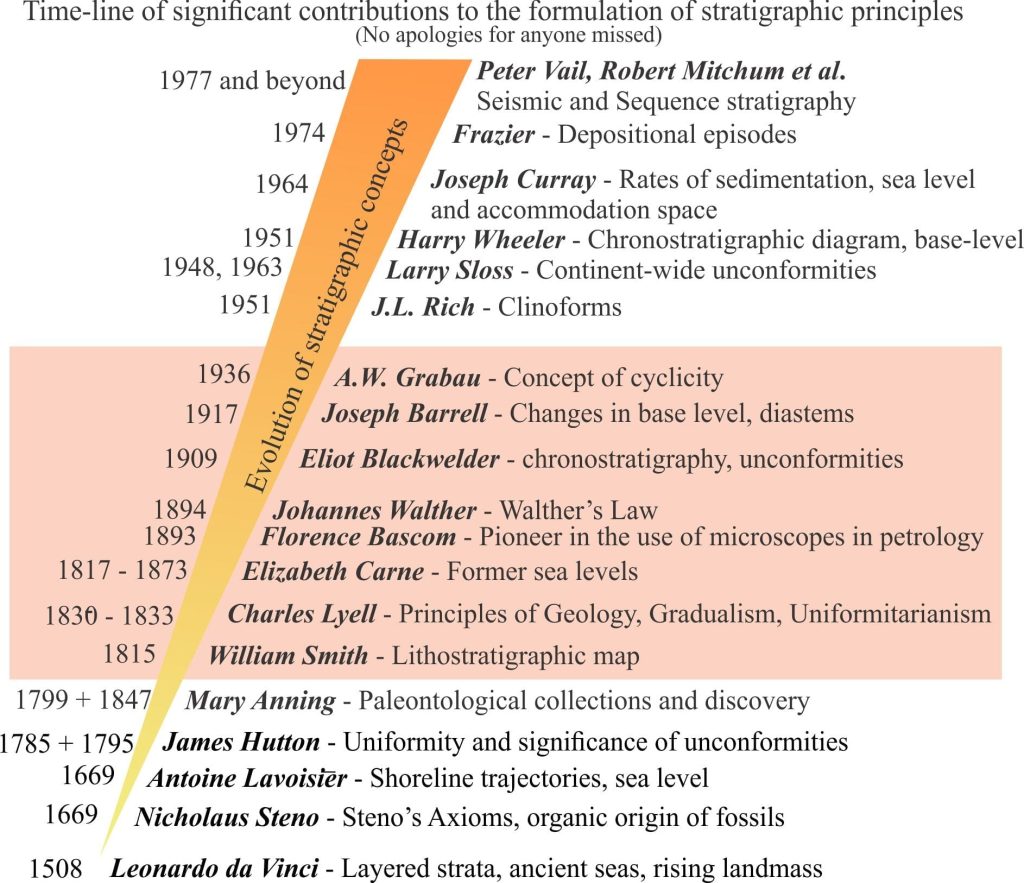
This is the second of three posts that look briefly at the development of stratigraphic principles and the characters responsible for them, spanning the 19th through early 20th centuries.
This is part of the How To…series on Stratigraphy and Sequence Stratigraphy
Preamble: My intent was to write a single post on this topic, as an introduction to Stratigraphy in general, and Sequence Stratigraphy in particular. But I kept adding names to the timeline, and got carried away with some of the characters on it. So, the number of posts was expanded.
William Smith (1769-1839)
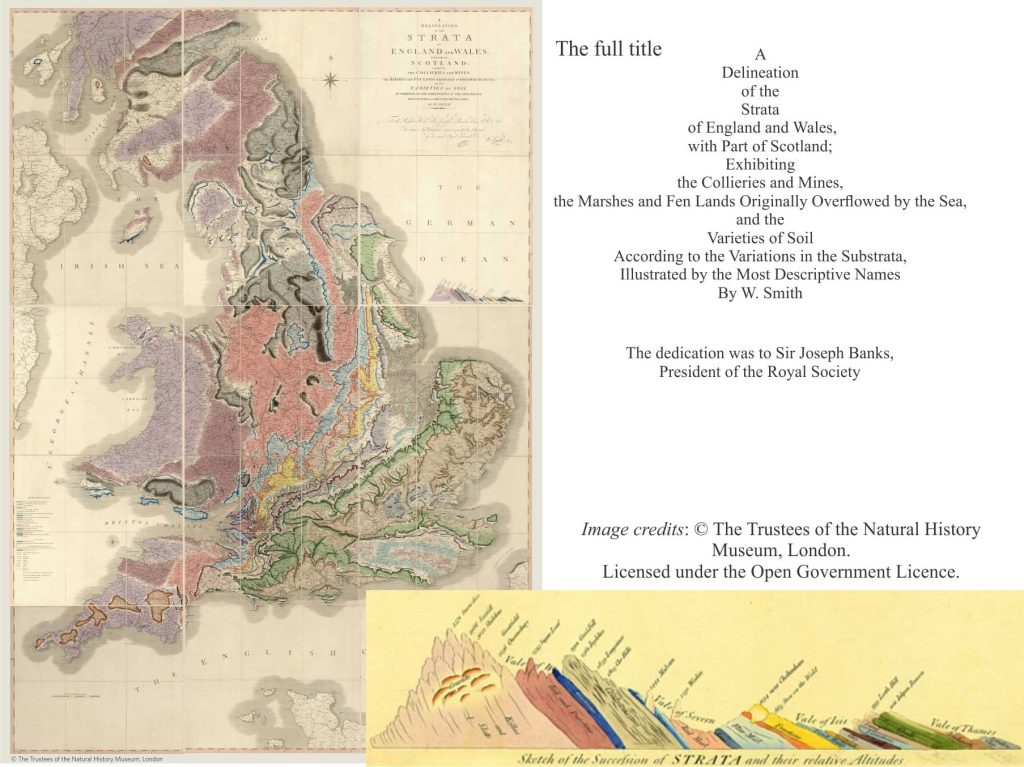
“It was the work of genius, and at the same time a lonely and potentially soul-destroying project. It was the work of one man, with one idea, bent upon the all-encompassing mission of making a geological map of England and Wales” (quoted from Simon Winchester’s excellent account, 2001, p.195). The Map, the one that changed the world, was published on August 1, 1815. Four hundred coloured copies were printed, of which only a few remain. It almost covers an entire wall at about 2.6m high, and 1.9m wide. Its compilation required years of exhausting and costly field work – Smith was not a wealthy man, nor of gentlemanly status. He covered more than 130,000 square kilometres mapping and measuring, collecting thousands of fossils. His rock units, many of which were well known, were defined by lithology and fossil content – fossils were particularly important for correlation. Much of the original work was undertaken while surveying new canals.
The beauty of the Map lies in its artistry, the intellect behind its construction, and the important scientific and technological advantages of being able to see, at a glance, the geology of an entire county or country. I have seen one of the surviving copies in the Geological Society (London) foyer. It is stunning.
Upon publication, William Smith was celebrated, at least for a brief period. But the undercurrent of insults and condescension, and an even worse indignity, plagiarism, continued. However, a degree of fortune was to return in 1831 when he was celebrated as the first recipient of the Geological Society’s Wollaston Medal. In his delivery speech, Adam Sedgewick (in important personality in 19th century English geology) even referred to him as the Father of English Geology.
Charles Lyell (1797-1875)
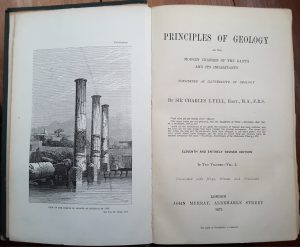
Lyell was a quintessential Victorian gentleman (later a Baron), lawyer, and the most influential geologist of the time. He championed Hutton’s uniformitarianism and deep time, providing a Gradualist’s antidote to the prevailing Catastrophism. For Lyell (and Hutton) the upheavals and contortions of the Earth required time beyond reckoning. Although he could remove himself from these Catastrophist reckons, he was acutely aware that some Earth processes can occur rapidly in a geological sense. The frontispiece to Volume 1, the Roman Temple of Seraphis in Pozzuoli (near Naples) illustrates his ability to decipher geological events; the temple columns, partially submerged in 1828 when he observed them, contain clusters of bivalves about 2.7m above the water line. He deduced that the columns must have been almost fully submerged, and later uplifted. In fact, today they are more than 3m above the water line.
His first edition of The Principles of Geology was in 3 volumes, the 1st edition published 1830-33. They constitute one of the first set of texts that deals with pretty well everything geological – from sedimentary to igneous and volcanic processes, earthquakes, the uplift of mountains and the erosion that wore them down, fossils, climate, past glaciations. These weighty tomes were hugely influential to young Charles Darwin who obtained copies during his time on the Beagle (December 1831 to October 1836. Lyell was later to become a good friend and arm-twister to Darwin.
Elizabeth Carne (1817-1873)
Carne combined banking and philanthropy with her love of geology, the latter undertaken in Cornwall. She published four papers in the Royal Geological Society of Cornwall Transactions (she was the first female member elected to this society), including one that reveals a description of ancient sea levels; Cliff Boulders and the Former Condition of the Land and Sea in the Land’s End district. She identified features of the boulders that were like modern deposits along the Land’s End shore, but elevated well above the present shoreline. She was well read, but I cannot ascertain whether she was conversant with the Hutton or Lyell texts. Regardless, her interpretation of the boulders as an ancient beach, formed at a different relative sea level, shows interpretive skills that extended beyond the standard diluvian dogma.
Florence Bascom (1862-1945)
Florence Bascom’s contributions to geology and stratigraphy were numerous, but key among them were her pioneering efforts in developing microscopy as a tool for unraveling rock histories (petrology), and a love of teaching that culminated with her founding the geology department at Bryn Mawr College in Pennsylvania. She applied the principles of crystallography and petrography to sedimentary rocks, having learned the skills studying crystalline rocks. An ability to extend these skills enabled her to decipher sediment provenance, and to distinguish between metamorphosed rocks and non-metamorphosed sediments (this was the topic of a dissertation). She became an expert in Appalachian geology. Microscopy in all its forms continues to play a vital role in many facets of geology.
She earned four degrees, the final one a PhD at Johns Hopkins University in 1893 – not only the first geology doctorate, but the first woman to earn a PhD there. Bascom was the first woman to be hired as a geologist by the U.S. Geological Survey, and the first woman to be elected to the Geological Society of America in 1924.
Johannes Walther (1860-1937)
Walther was a German geologist who gave us The Law of Correlation (or Succession) of Facies, published in 1894 (and translated from German by Gerald Middleton 1973). He became a student of science and geology at a young age (12-15), one of his early mentors being Ernst Haeckel, a biologist, a Darwinist, and brilliant illustrator of living and fossil organisms.
His investigations involved marine geology, comparisons of modern and ancient sedimentary processes (uniformitarianism), was one of the earliest to recognize bioerosion as a significant source of carbonate sediment, and established that coral reefs had rigid frameworks plus interstitial sediment. Later in life he became a professor and dean (Gischler, 2011).
We remember Walther primarily for his ‘Law’, that is an essential part of any modern analysis of sedimentary facies and depositional systems (most English-speaking students will only be familiar with Middleton’s translation and commentary.
‘‘. . . only those facies and facies-areas can be superimposed primarily which can be observed beside each other at the present time’’ (Walther 1894). Stated another way Walther’s Law indicates that facies that form coevally in laterally contiguous environments can be superposed vertically. It is possible that Walther was pre-empted by Lavoisier’s analysis, but Walther was the first to formally state the condition for facies disposition.
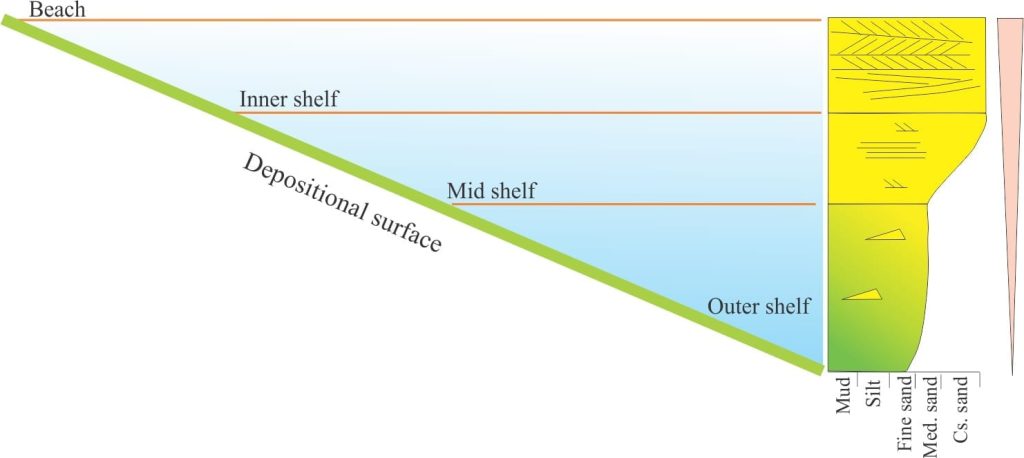
The example shown depicts a traverse from beach to outer shelf, with concomitant changes in sediment (particularly grain size and sorting), benthic fauna and flora, and sedimentary structures. Assuming no significant interruption, the facies progression will be translated to a hypothetical stratigraphy, in this case under conditions of regression and seaward migration of the shoreline.
Eliot Blackwelder (1880—1969)
Blackwelder was essentially a field geologist, known for his scrupulous attention to detail and observation, as broad-based in his interests as any Victorian gentleman naturalist. There are several reasons why his inclusion in the timeline is warranted, but key among them is a paper on unconformities published in 1909. He was the first to identify continent-wide successions of Phanerozoic strata, each separated by profound unconformities. We now refer to these successions as sequences.
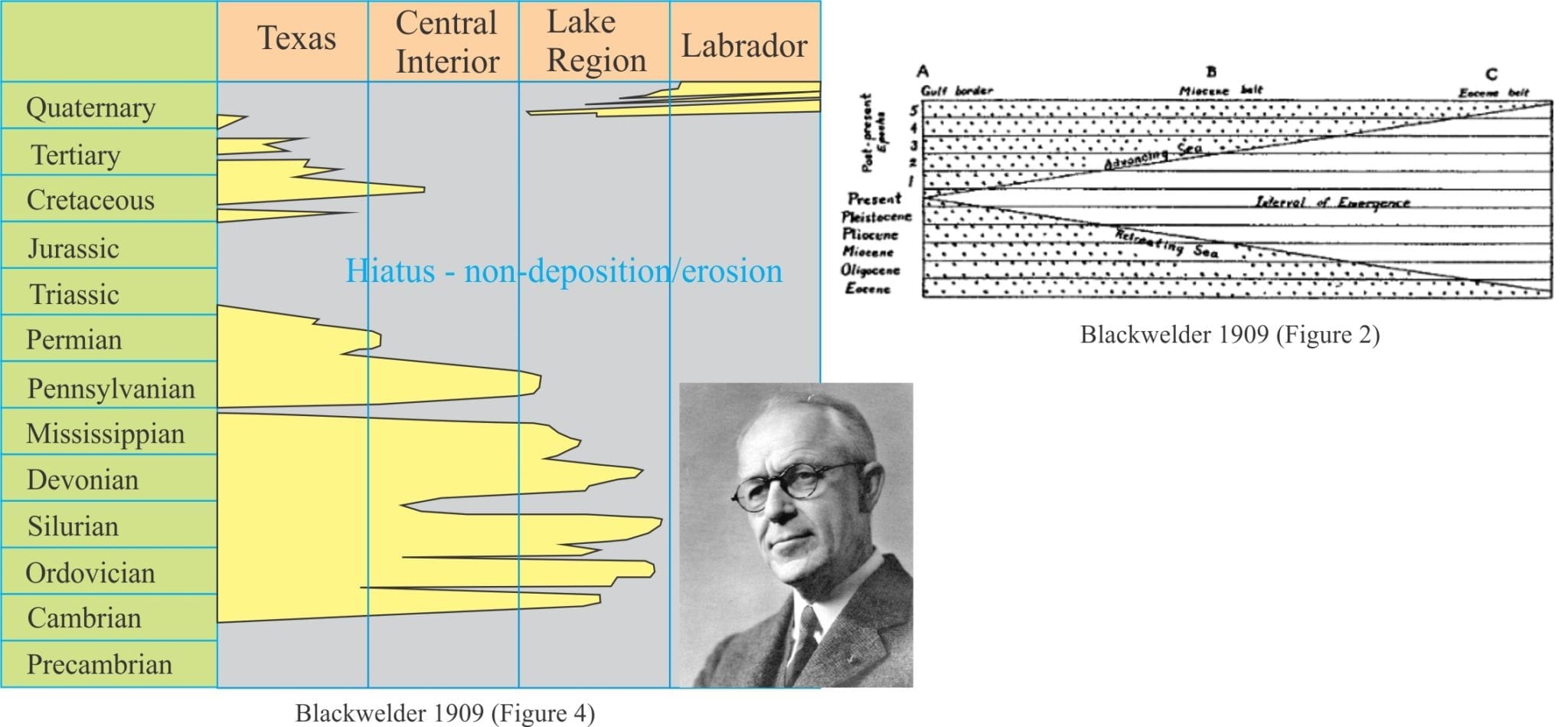
His Figure 2 is one of the earliest graphical portrayals of the chronostratigraphic significance of unconformities. The stratigraphic succession at A is continuous, but from B through C the duration of missing time increases, that he attributes to erosion of the rock record. The rise and fall of sea level (transgression and regression), and concomitant landward or seaward migration of the shoreline, produces a mappable contact that is diachronous. The diagram on the right is remarkably similar to Grabau’s 1906 Figure 7.
His scheme of unconformity-bound successions was expanded by Larry Sloss in 1949.
An excellent publication by Andrew Miall (2016) revisits Blackwelder’s unconformities, evaluating them in a more recent context.
Joseph Barrell (1869-1919)
Barrell’s interests extended from the global (heat production, isostasy) to the origin of sedimentary facies and depositional rhythms, or cycles. His classic paper on cyclicity (1917; a 159 page tome) considered stratigraphic rhythms and rates of denudation and sedimentation. He portrays these cycles in the context of changing baselevels, one of the first explicit explanations of the value of a datum in stratigraphy. His Figure 5, that could be transposed to any modern publication on changing sea levels, shows the effects on sedimentation from harmonic oscillations in baselevel.
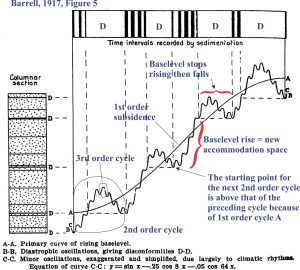
The diagram models:
- The long-term change in baselevel caused by subsidence (curve A),
- Long-period oscillations, or 2nd order cycles caused by tectonism, and
- Short period (higher order) cycles caused by fluctuating climate.
Higher order cycles are superimposed on long period cycles; we certainly know this to be true, for example Milankovitch astronomical cycles that drive oscillations in climate. Barrell then correlates changing baselevels with the deposition of sediment, and periods of little or no sedimentation that he calls diastems (D on the stratigraphic column) caused by a reduction in sediment supply and/or erosion. The corresponding time intervals are shown in the top bar – solid black lines represent sedimentation, blank spaces represent diastems.
Barrell’s diagram further illustrates:
- Stratigraphic columns may appear to represent continuous sedimentation, but in fact they contain long periods with no sedimentation.
- Whether sedimentation or diastemic breaks occur depends on the overall effect on baselevel of all three cycles, and
- Sedimentation only occurs when the overall baselevel is rising. In other words, when there is space to put sediment. We now refer to this as accommodation space. In his own words “…the deposition of nearly all sediments occurs just below the local baselevel represented by wave base or river flood level, and is dependent on upward oscillations of baselevel or downward oscillations of the bottom, either of which makes room for sediments below baselevel.” (p. 747). Some of the jargon has changed, but this is essentially a modern statement about baselevel controls on sedimentation.
Amadeus William Grabau (1870-1946)
Grabau was an American paleontologist who, in addition to important work in continental USA, also spent a significant part of his life in China. Of his many books, three that deserve mention here are On the Classification of Sedimentary Rocks (1904), Principles of Stratigraphy (1913), and importantly Rhythm of the Ages (1940) where he elaborates on his pulsation theory (a theory introduced in 1933 at the International Geological Congress, Washington).
The Pulsation Theory attempts to explain the repetition through time of strata having similar sedimentary and paleontological attributes. Repetition of these successions of strata, more commonly known as cycles and cyclicity, resulted from successive marine transgressions and regressions (about 20 years after Barrell’s model if cyclicity). Grabau was one of the first exponents of Global Eustasy, where advancing seas were caused by expansion of the oceans, and vice versa retreating seas. From his correlations of Phanerozoic stratigraphy, he reconstructed continental paleogeographies that were also consistent with Alfred Wegener’s ideas on continental drift.
Grabau extended Walther’s Law, recognizing that there are gaps in time caused by sedimentary processes, particularly erosion during shoreline seaward retreat. He coined the term hiatus to describe the absence of a rock record between pulsations, or cycles. The diagram below from Figure 7 of a 1906 publication shows a stratigraphic (left) and corresponding chronostratigraphic representation; the similarity to more recent diagrammatic expressions of onlap and offlap is striking. Note that this also approximates a sea-level curve.

Other posts in this series:
A timeline of stratigraphic principles; 15th to 18th C
A timeline of stratigraphic principles; 1950-77
Baselevel, Base-level, and Base level
Sediment accommodation and supply
Autogenic or allogenic dynamics in stratigraphy?
Stratigraphic cycles: What are they?
Sequence stratigraphic surfaces
Shorelines and shoreline trajectories
Stratigraphic trends and stacking patterns
Stratigraphic condensation – condensed sections
Depositional systems and systems tracts
Which sequence stratigraphic model is that?
References
J. Barrell, 1917. Rhythms and the measurements of geologic time. Geological Society of America Bulletin v.28, p. 745-904.
E. Blackwelder 1909. The valuation of uncomformities. Journal of Geology, v.17, p.289-299. Available for download
E. Gischler, 2011. Johannes Walther (1860–1937): More than the law of facies correlation. GSA Today, August, 2011, p. 12-13.
A.W. Grabau, 1906. Types of sedimentary overlap. Geological Society of America Bulletin, v.17, p. 567-636.
A.W. Grabau, 1940. Rhythm of the Ages. Peking: Henri Vetch, 561 p.
C. Lyell, 1872. Principles of Geology, Volume 1. Eleventh Edition. John Murray, London.
A.D. Miall, 2016. The valuation of unconformities. Earth Science Reviews, v. 163, p. 22-71
G.V. Middleton, 1973. Johannes Walther’s Law of the Correlation of Facies. Geological Society of America Bulletin, 84: 979–988.
S. Winchester, 2001. The Map That Changed the World: The tale of William Smith and the birth of a science. Viking, 338 pp.


















